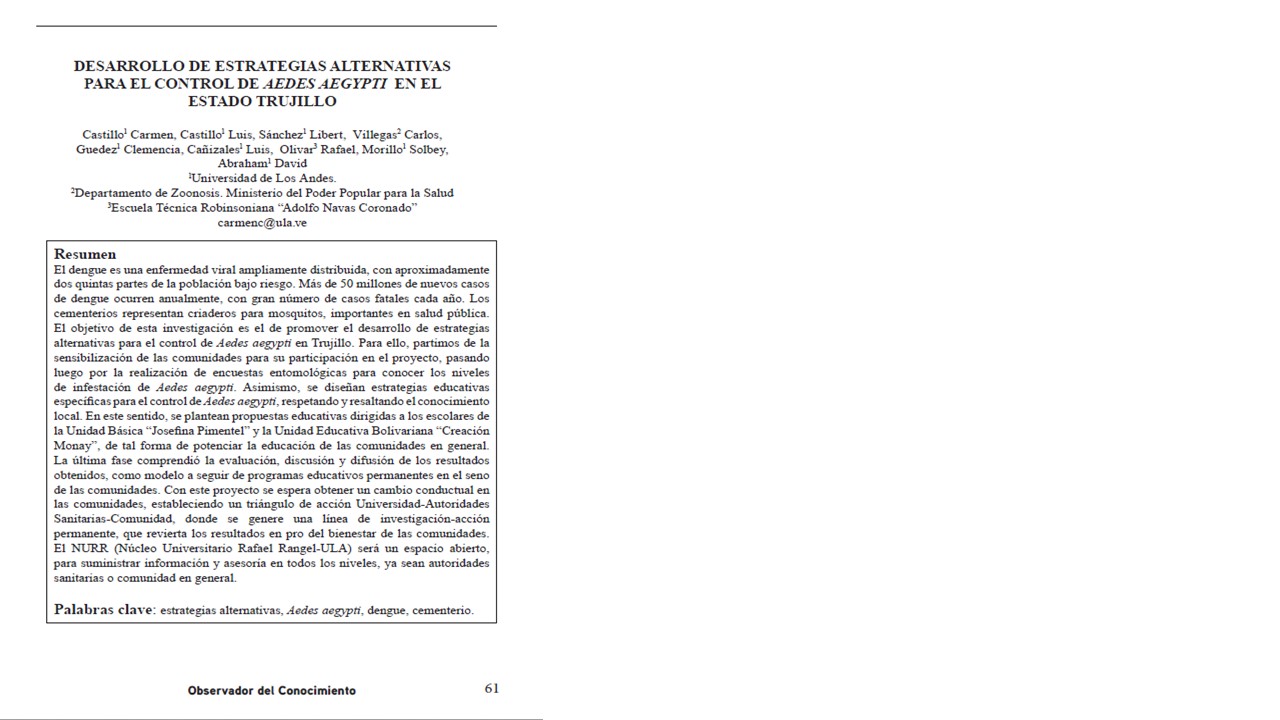Desarrollo de Estrategias Alternativas para el Control de Aedes Aegypti en el Estado Trujillo
Palabras clave:
Estrategias alternativas, Aedes aegypti, dengue, cementerioResumen
El dengue es una enfermedad viral ampliamente distribuida, con aproximadamente dos quintas partes de la población bajo riesgo. Más de 50 millones de nuevos casos de dengue ocurren anualmente, con gran número de casos fatales cada año. Los cementerios representan criaderos para mosquitos, importantes en salud pública. El objetivo de esta investigación es el de promover el desarrollo de estrategias alternativas para el control de Aedes aegypti en Trujillo. Para ello, partimos de la sensibilización de las comunidades para su participación en el proyecto, pasando luego por la realización de encuestas entomológicas para conocer los niveles de infestación de Aedes aegypti. Asimismo, se diseñan estrategias educativas específicas para el control de Aedes aegypti, respetando y resaltando el conocimiento local.
Descargas
Citas
Abe, M., McCall, P., Lenhart, A., Villegas, E. y Kroeger, A. (2005). The Buen Pastor cemetery in Trujillo, Venezuela: measuring dengue vector output from a public area. Tropical Medicine and International Health, 10, 597-603.
Arias, J. (2002). Dengue in Cuba. Revista Panamericana de Salud Pública, 11, 221-222.
Barrera, R., Navarro, J., Mora, J., Domínguez, D. y González, J. (1995). Public service deficiencies and Aedes aegypti breeding sites in Venezuela. Bulletin Pan American Health Organization, 29, 193-205.
Barrera, R., Machado, C., Bulla, L. y Strong, D. (1982). Mosquitoes and mourning in the Caracas Cemetery. Antenna, 6, 250-252.
Barrera, R., Machado, C. y Bulla, L. (1979). Breeding places, larval density and niche segregation in three urban culicidae (Culex fatigans Wied., C. corniger Theo., and Aedes aegypti l.) at Caracas cemetery. Acta Científica Venezolana, 30, 418-424.
Chadee, D., Williams, F. y Kitron, U. (2005). Impact of vector control on a dengue fever outbreak in Trinidad, West Indies, in 1998. Tropical Medicine and International Health, 10, 748-754.
Dirección Regional de Epidemiología y Estadística Vital – Trujillo (2009). Boletín Epidemiológico. Caracas: Ministerio del Poder Popular para la Salud.
Guzmán, M., Kouri, G., Díaz, M., Llop, A., Vázquez, S., González, D., Castro, O., Álvarez, A., Fuentes, O., Montada, D., Padmanabha, H., Sierra, B., Pérez, A., Rosario, D., Pupo, M., Díaz, C. y Sánchez, L. (2004). Dengue, one of the great emerging health challenges of the 21st century. Expert Review of Vaccines, 3, 511-520.
Gubler, D. (1998). Dengue and dengue hemorrhagic fever. Clinical Microbiology Reviews, 11, 480-496.
Guzmán, M. y Kouri, G. (2002). Dengue: an update. Lancet Infectious Diseases, 2, 33-42.
Guzmán, M., García, G. y Kouri, G. (2006). Dengue and dengue hemorrhagic fever: research priorities. Revista Panamericana de Salud Pública, 19, 204-215.
Guzmán, M., Kouri, G., Bravo, J., Soler, M., Vázquez, S. y Morier, L. (1990). Dengue hemorrhagic fever in Cuba, 1981: a retrospective seroepidemiologic study. American Journal of Tropical Medicine and Hygiene, 42, 179-184.
Guzmán, M., Kouri, G., Bravo, J., Soler, M., Vázquez, S., Santos, M., Villaescusa, R., Basanta, P., Indan, G. y Ballester, J. (1984). Dengue haemorrhagic fever in Cuba. II. Clinical investigations. Transaction Royal Society and Tropical Medicine and Hygiene, 78, 239-241.
Kouri, G., Guzmán, M., Bravo, J. y Triana, C. (1989). Dengue haemorrhagic fever/dengue shock syndrome: lessons from the Cuban epidemic, 1981. Bulletin World Health Organization, 67, 375- 380.
Lenhart, A., Castillo, C., Oviedo, M. y Villegas, E. (2006). Use of the pupal/ demographic-survey technique to identify the epidemiologically important types of containers producing Aedes aegypti (L.) in a dengue-endemic area of Venezuela. Annals of Tropical Medicine and Parasitology, 100 Suppl 1, S53-S59.
Ligon, B. (2005). Dengue fever and dengue hemorrhagic fever: a review of the history, transmission, treatment, and prevention. Seminars in Pediatric Infectious Diseases, 16, 60-65.
Lloyd, L.; Winch, P.; Ortega, J.; Kendall, C. (1992). The design of a community-based health education intervention for the control of Aedes aegypti. American Journal of Tropical Medicine and Hygiene. 50: 401-411.
Nathan, M.; Focks, D.; Kroeger, A. (2006). Pupal/demographic surveys to inform dengue-vector control. Annals of Tropical Medicine and Parasitology, 100 Suppl 1, S1-S3.
Navarro, J.; Zorrilla, A.; Moncada, N. (2009). Primer registro de Aedes albopictus (Skuse) en Venezuela. Importancia como vector de Dengue y acciones a desarrollar. Boletín de Malariología y Salud Ambiental. 49 (1).
Pan American Health Organization – PAHO (2008). Number of Reported Cases of Dengue & Dengue Hemorrhagic Fever (DHF), Region of the Americas (by country and sub-region), [en línea]. Recuperado el 12 de noviembre de 2010, de http://www.paho.org/english/ad/dpc/ cd/dengue.htm
Pan American Health Organization – PAHO (1997). Re-emergence of Dengue in the Americas Epidemiological Bulletin. PAHO, 18.
Troyo, A., Calderon, O., Fuller, D., Solano, M., Avendaño, A., Arheart, K., Chadee, D. y Beier, J. (2008). Seasonal profiles of Aedes aegypti (Diptera: Culicidae) larval habitats in an urban area of Costa Rica with a history of mosquito control. Journal of Vector Ecology, 33, 76-88.
World Health Organization (2012). Dengue and severe dengue. Fact sheet, 117.
World Health Organization (2009). Dengue: Guidelines for diagnosis, Treatment, Prevention and Control. Ginebra: WHO Press. World Health Organization (2001). World Health Organization Regional Office for South-East Asia. Guidelines for treatment of dengue fever/dengue hemorrhagic fever in small hospitals. New Delhi: Searo.
World Health Organization (1997). Dengue haemorrhagic fever: Diagnosis, treatment, prevention and control. Ginebra: WHO Press.

Descargas
Publicado
Cómo citar
Número
Sección
Licencia

Esta obra está bajo una licencia internacional Creative Commons Atribución-SinDerivadas 4.0.







